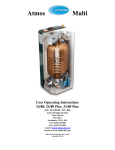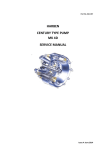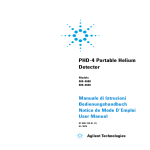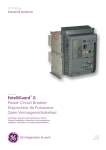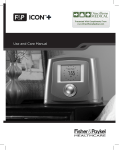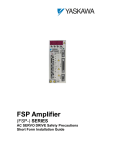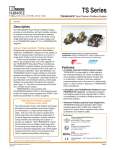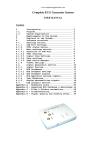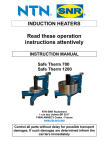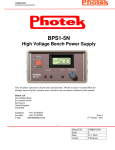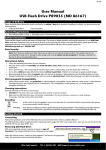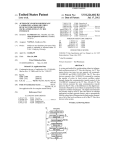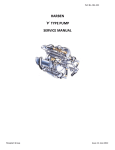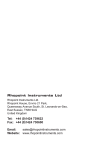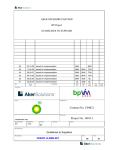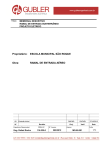Download ME3 Manual - FindTheNeedle.co.uk
Transcript
29 - 30 Brunel Road, Churchfields Industrial Estate, St. Leonards-on-Sea East Sussex. TN38 9RT. United Kingdom Sales & Service : 01424 853 013 All Other Departments : 01424 853 464 Fax : 01424 852 268 [email protected] [email protected] Magnus Power ME3 Three Phase Frequency Converter - Manual ME3 Three Phase Frequency Converter, Operation and Maintenence. Magnus Power 29 - 30 Brunel Road, St Leonards on Sea, East Sussex, TN38 9RT. United Kingdom Telephone +44 (0) 1424 853 013 (Sales & Service) +44 (0) 1424 853 464 (all other Enquires) Fax +44 (0) 1424 853 2 268 web - www.magnuspower.co.uk www.magnuspower.co.uk [email protected] [email protected] e-mail - [email protected] ME3 Manual Rev 1 CONTENTS 1 MAGNUS POWER ME3 SFC STATIC FREQUENCY CONVERTER USER MANUAL 2 CONTENTS CONTENTS 3 CONTENTS CONTENTS ................................................................................................................................ 3 PRINCIPLES OF OPERATION.................................................................................................. 5 INTRODUCTION .................................................................................................................... 5 START UP AND SHUT DOWN .............................................................................................. 6 RECTIFIER ............................................................................................................................. 7 INVERTER .............................................................................................................................. 8 MICRO PROCESSOR DISPLAY AND FAULT FINDING....................................................... 9 MIMIC PANEL ........................................................................................................................................................ 9 PUSH BUTTONS ................................................................................................................................................. 10 LOGGER DISPLAY.............................................................................................................................................. 12 DIGITAL LCD DISPLAY ....................................................................................................................................... 13 SELECTION OF EQUIPMENT................................................................................................. 16 ME3 MODELS:...................................................................................................................... 16 PARALLELING...................................................................................................................... 17 SIZING THE SFC .................................................................................................................. 18 INSTALLATION ....................................................................................................................... 19 INSTALATION DATA ............................................................................................................ 19 SFC DIMENSIONS (mm) ..................................................................................................................................... 19 INSTALLATION: .................................................................................................................................................. 20 LTDB: ................................................................................................................................................................... 24 ACOUSTICAL NOISE: ......................................................................................................................................... 25 VENTILATION AND AIR CONDITIONING .......................................................................................................... 25 ELECTRICAL CHARACTERISTICS ....................................................................................... 26 ELECTRICAL CHARACTERISTICS ..................................................................................... 26 CABLES SELECTION .............................................................................................................27 CABLES SELECTION .......................................................................................................... 27 HARMONICS FROM RECTIFIER ............................................................................................ 28 4 QUADRANT POWER FACTOR CORRECTED ACTIVE RECTIFIER .............................. 28 4 CONTENTS EFFECTS OF HARMONICS ON OTHER EQUIPMENT ...................................................... 29 SFC SPECIFICATIONS ...........................................................................................................30 SFC SPECIFICATIONS ........................................................................................................ 30 GUARANTEE ........................................................................................................................... 31 MAINTENANCE AND BACKUP SERVICE .......................................................................... 31 PRINCIPLES OF OPERATION 5 PRINCIPLES OF OPERATION INTRODUCTION The ME3 three phase Static Frequency Converter (SFC). guarantees a supply free of disturbances and of high quality, with maximum reliability. The use of high frequency pulse width modulation (PWM) ensures exceptional performance and extremely quiet operation. A 4 quadrant Power Factor Corrected RECTIFIER guarantees lower input currents, reduced harmonics (THD<5%) and the capability to handle any type of load including regenerative ones. The advantages of this technology are: • • • • • Fast response to load changes. Quiet operation. Reduction in size and weight. High efficiency - low heat losses. Short circuit protection. If your load is sensitive to mains supply, such as computer Systems, process electronics, emergency equipment etc., then the SINE33 is the answer. The ME3 SFC comprises the following: • • MAINS INPUT Rectifier Inverter AC DC DC AC RECTIFIER INVERTER SFC OUTPUT INTRODUCTION PRINCIPLES OF OPERATION 6 START UP AND SHUT DOWN POWER UP SEQUENCE 1. Switch on “AUX. SUP SWITCH” (Electronics should start up) 2. Switch on “INPUT MCB” 3. Switch on ”OUTPUT ISOLATOR” 4. Switch Inverter on by pressing the Green button. POWER DOWN SEQUENCE 1. Switch Inverter off by pressing both Red Buttons simultaneously 2. Switch off “OUTPUT ISOLATOR” 3. Switch off “INPUT MCB” 4. Switch off “AUX.SUP SWITCH” Any other sequence will not cause any harm to the SFC. Make sure that the Auxiliary Supply Switch is always ON when operating the SFC. This will allow the SFC to operate correctly in the event of Mains Supply dips. START UP AND SHUT DOWN PRINCIPLES OF OPERATION 7 RECTIFIER DC TO INVERTER MAINS INPUT 4 QUAD. CONVERTER The rectifier / charger comprises: • • • • • RFI Filter. Input triple pole circuit breaker for protection against faults. MOV input protection against over voltage transients. LC filter. 4 Quadrant, PF Correction IGBT Bridge. The Rectifier supplies the Inverter with a constant DC voltage . The Power Factor Correction IGBT Bridge (4 Quad. Converter) guaranties input unity power factor and sinusoidal current with low Harmonic content, as well as 4 quadrant operation. RECTIFIER PRINCIPLES OF OPERATION 8 INVERTER The basic principle of operation of the Inverter is achieved by having a voltage loop control followed by a current loop control which maintains the output voltage and wave shape constant and with no DC offset. To create the sinusoidal wave shape, the DC supply is switched on and off with varying pulse length (pulse width modulation). These pulses are then filtered by a LC filter producing a low distortion sine wave in the output. DC FROM RECT. TRANSFORMER INVERTER The Inverter consists of: • • • • INVERTER 3 Phase IGBT Bridge L C Filter Inverter transformer Control circuitry OUTPUT PRINCIPLES OF OPERATION 9 MICRO PROCESSOR DISPLAY AND FAULT FINDING 2 1 1 2 3 4 6 5 7 2 The display panel consists of a digital display, a mimic display, a diagnosis display, an audible alarm and push buttons MIMIC PANEL MIMIC POSITION INDICATION FLAG IN THE DIGITAL DISPLAY 1 - INPUT FAILURE “RECTIFIER OFF” 2- INVERTER OFF “INVERTER OFF”. MICRO PROCESSOR DISPLAY AND FAULT FINDING PRINCIPLES OF OPERATION 10 PUSH BUTTONS DISPLAY POSITION PUSH BUTTON NAME PUSH BUTTON FUNCTION 1- INVERTER ON (green) It will turn the UPS Inverter ON, if no fault is present. 2- INVERTER OFF (red) To switch the UPS Inverter OFF and transfer the load to Static Bypass, both red buttons must be pressed simultaneously. 3- INDICATION RESET (R) This pushbutton performs the following functions simultaneously when pressed: a) Some fault indications in the Digital Display will latch when triggered. This push-button will Reset these indications if the respective fault has cleared. b) It Resets the audible alarm. c) It will reset and restart the Rectifier (only) after a Rectifier trip. d)It will exit the Logger display, if in this mode. 4- FLAG SCROLL UP If more than two Status flags are present in the Digital Display, by pressing this button the flags will scroll up. When there are no more flags above the “ “ symbol will show next to the flag. If there are more flags above an arrow will be seen next to the flag. To scroll 5 items at a time press this button and while maintaining it depressed, press the FLAG SCROLL DOWN also. 5- FLAG SCROLL DOWN The same as for the “ Flag Scroll Up “ but in the downwards direction. To scroll 5 items at a time press this button and while maintaining it depressed, press the FLAG SCROLL UP also. 6- METER SCROLL UP Only two readings from the Meter will be shown at any one time. By pressing this button the meter readings will scroll up. When there are no more readings above the “ “ symbol will show next to the last meter reading. If there are more readings above an arrow will be seen. To scroll 5 items at a time press this button and while maintaining it depressed, press the METER SCROLL DOWN also. MICRO PROCESSOR DISPLAY AND FAULT FINDING PRINCIPLES OF OPERATION 7- METER SCROLL DOWN 11 The same as for the “ Meter Scroll Up “ but in the downwards direction. To scroll 5 items at a time press this button and while maintaining it depressed, press the METER SCROLL UP also. 4-5-6-7 ALL SCROLL BUTTONS MICRO RESET Pressing all scroll buttons simultaneously will reset the Micro. After reset all LEDs will light up momentarily, allowing to check faulty ones. 3-4/5 RESET + FLAG SCROLL LOGGER By pressing the Reset Button and any of the Flag Scroll buttons simultaneously, the display will enter the Logger. In this mode buttons 4 and 5 will provide a normal scroll while buttons 6 and 7 will provide a 5 item scroll. MICRO PROCESSOR DISPLAY AND FAULT FINDING PRINCIPLES OF OPERATION 12 LOGGER DISPLAY To check the history of the information from the previous section, the Display Logger can be activated, by pressing simultaneously the Reset button and any of the Digital Scroll Buttons (left hand side ones). To exit the Logger mode the Reset button must be pressed. The Display Logger uses all 4 lines of the LCD. An example: 19-10-04 6:30 G4-FE DIG SIGNALS = 11111110 19-10-05 6:20 G1-EF DIG SIGNALS = 11101111 Two events are shown. Both happened at the date 19-10-04. The first one at 6:30 and the fault belongs to group 4 (“Load on Bypass”). The second one happened at 6:20 and the fault belongs to group 1(“Bat Undervolt”). The zeros indicate the faults that triggered the event. The next table helps to identify the protections that triggered the events from the information above (Position 1 = Least Significant Bit). The left hand side scroll buttons will scroll the logger lines one by one and the right hand side buttons will scroll 5 lines at a time. It must be noted that the same information, in a more user-friendly format, is also available using our Windows based software or a Netagent connection. Group Position G1 1 G2 G3 CHARGER OVERVOLT INVERTER SAT PROT INVERTER OVERCURRENT INVERTER UNDERVOLT INVERTER OVERVOLT 2 ON LINE EMERG POWER OFF CHARGER FAULT 3 MAINS LOW CHARGER BOOST 4 MAINS HIGH BAT DISCHARGING 5 BAT UNDERVOLT RECT OVERVOLT 6 BAT HALF RECT FAULT G5 LOAD ON BYPASS BUTTON ON MANUAL BYPASS BUTTON OFF OUT OF SYNC REMOTE OFF FUSE FAILURE REMOTE ON BATTERY TEST - 7 BAT LOW INVERTER OFF SHORT CIRCUIT INV DC OFFSET DC OUT OF BALANCE BAT. EARTH LEAKAGE 8 CHARGER OFF UNVERTER FAULT PHASE ROTATION OUTPUT ISOLATED MICRO PROCESSOR DISPLAY AND FAULT FINDING OVERLOAD OVERTEMPERATUR E G4 MICRO RESET - PRINCIPLES OF OPERATION 13 DIGITAL LCD DISPLAY METER DISPLAY: The first two lines of the LCD are used for the Meter functions. They can be scrolled by the two right hand side buttons. The following functions are available: METER FUNCTION DESCRIPTION “Inv Volt PH A =” Phase A Inverter voltage (V). “Inv Volt PH B =” Phase B Inverter voltage (V). “Inv Volt PH C =” Phase C Inverter voltage (V). “Op Curr PH A =” Phase A Output Current (%). “Op Curr PH B =” Phase B Output Current (%). “Op Curr PH C =” Phase C Output Current (%). “Input Volt PH A =” Phase A Input voltage (V). “Input Volt PH B =” Phase B Input voltage (V). “Input Volt PH C =” Phase C Input voltage (V). “Input Curr PH A =” Phase A Input Current (%). “Input Curr PH B =” Phase B Input Current (%). “Input Curr PH C =” Phase C Input Current (%). “Pk Op Curr PH A =” Phase A Peak Output Current (%). “Pk Op Curr PH B =” Phase B Peak Output Current (%). “Pk Op Curr PH C =” Phase C Peak Output Current (%). “DC Link Volt =” DC Link Voltage (V). “DC Link Curr =” DC Link Current (%). “Input Freq =” Mains Input Frequency (Hz). “Invert Freq =” Inverter Frequency (Hz). “Temperature =” Cabinet Interior Temperaure Every single one of these measurements can be eliminated from the display in the Display Configuration Program. MICRO PROCESSOR DISPLAY AND FAULT FINDING PRINCIPLES OF OPERATION 14 STATUS FLAG DISPLAY / FAULT FINDING The Status Flag display (3rd and fourth row) provides enough information for the SFC user to know the operational status of the SFC, as well as in the case of a fault if a technician should be contacted. If no flags are active the third row will show “ Power System OK”. If any flag is active the flags messages will appear in the third and fourth rows of the LCD. The left-hand side buttons will scroll the flags. The following indications are available: “Mains Low” Mains are absent or bellow limits (-20% of nominal). “Inverter Fault” ; “Inverter Sat Prot” ; “Inverter Overcurr” ; “Inverter Undervolt” ; “Inverter Overvolt” These indications indicate that the Inverter has been subjected to high stress such as excessive current flown through the IGBT’s causing the Inverter to trip. These indication are self-latching. To clear them, the “INDICATION RESET” push button ® must be pressed. If after restarting the Inverter, any of these indications persist, there is a fault in the Inverter and the SFC supplier should be contacted. No further attempts at restarting the Inverter should be made. “Overtemperature” The SFC heat sinks’ temperature has exceeded 80ºC. Check if there is any obstruction to the ventilation inlets or outlets of the SFC and remove it. If that is not the problem, it is likely that one of the fans has gone faulty. Contact the SFC supplier. This indication is self-latching. To reset it, the fault must be cleared and the “INDICATION RESET” push button ® pressed. “Inverter Off” The SFC Inverter is off. If there is no other fault indication the Inverter was switched off manually. “Short Circuit” When the load current exceeds aproximately 10 times the nominal full load value, the Inverter is switched off. No SFC output will be available. At this stage, this indication and the audible alarm are active. Before trying to reset the SFC, make sure that the short circuit on the load is removed “Over Load” When the load current exceeds 105%, this indication will be triggered. The Inverter will try to cope with the overload, being protected by an inverse time protection: i.e. the larger the overload, the shorter the time the Inverter will take to switch off. Typically 1min for a 120% overload and 5 seconds for 150%. MICRO PROCESSOR DISPLAY AND FAULT FINDING PRINCIPLES OF OPERATION 15 “Mains High” The mains input is out of parameters (greater than 110%). The Power Factor Correction function of the Rectifier is inhibited. The SFC should not be operated in this conditions for a long period of time, since it exceeds its design parameters. “Phase Rotation” If the input phase rotation is not correct (R,Y,B), the indication will be ON. This happens when one of the phases is swapped around or failed. The Rectifier will not start. Normally this type of problem only arises in the initial installation of the machine and is easily rectified by swapping around two of the input phases for the Rectifier Input. “Rectifier Off” ; “Rect Overvolt” ; “Rectifier Fault” ; “DC Offset” ; “DC Out of Balance” The following conditions can cause these indications to be on: 1. Mains failure. 2. Mains input breaker in the SFC or Mains feeding breaker in the distribution box tripped. 3. Phase rotation on mains input incorrect. 4. Rectifier fault (DC over voltage or control voltage failure) 5. Inverter control failure causing DC Offset The above anomalies should be corrected as soon as possible, by calling the SFC supplier. “Fuse Fail” When available, this flag indicates one of the SFC main fuses has failed. Other indications, such as “Mains Failure” should give an idea of which fuse has failed. Otherwise a physical observation is necessary to discover the faulty fuse. This is better left done by the Maintenance personnel. The above fault finding information should be enough to solve any problem that might arise, and should give enough information about the status of the SFC at any moment. A remote alarm panel is available, with most of the diagnosis information of the SFC display panel, with exception of the digital meter. Also available are a relay interface card with the same characteristics and a network connection with SNMP protocol via Netagent, for easier access to all the SFC information. CONCLUSION: For the SFC to be in perfect working order, no red indication should be present on the display panel. The Status Digital Display should have only the flags “Power System OK!” and “P.S. Use=” ; the latter indicating the number of days the SFC has been in use. MICRO PROCESSOR DISPLAY AND FAULT FINDING SELECTION OF EQUIPMENT 16 SELECTION OF EQUIPMENT ME3 MODELS: The ME3 range of SFC comes in 8 different ratings as standard: 10KW – 15KW – 20KW – 30KW – 40KW – 50KW – 60KW – 80KW – 100KW. Single phase output units only go up to 50KW. For different power ratings from the above, you can consult us for advice. The above power ratings are for loads of UNITY power factor. These units can operate with loads of power factor ranging from 0.2 (leading or lagging) to unity due to the 4 quadrant operation of the Rectifier. The standard models cater for input voltages of 400V - 50Hz, with output voltages 200V - 60Hz ; 480V – 60Hz ; 200V – 400Hz. On request we can supply machines with different input and/or output voltages and frequencies. ME3 MODELS: SELECTION OF EQUIPMENT 17 PARALLELING It is also important to note that the ME3 models can be paralleled in a redundant mode to increase reliability or to increase power capability. The units to be paralleled must be of the same rating and no more than 4 in number. PARALLEL OPERATION When two or more units are connected in Parallel Redundant mode their outputs are connected to a common point via a current equalizing saturable choke as in Figure 16. They also interface with each other via a CAN Field Bus so that the instructions and controls are synchronized. Thus the parallel operation causes the following: - When the ON button is pressed in one SFC the Inverters of all SFC will turn ON (with no faults present). - If one SFC is switched OFF (manually or by a failure) the others will carry on supplying the load, while the former will be isolated from the load by its own Static Isolator. Besides the above, the operation of the Individual SFC is identical to a single SFC. SFC 1 MAINS INPUT OUTPUT SFC 2 PARALLELING SELECTION OF EQUIPMENT 18 SIZING THE SFC To size the SFC in a safe way the following points should be taken in to account: All the peak loads must be added. The sum of the peak loads must be divided by 1.5 and if the result is equal or larger than the sum of the steady loads times 1.2, this result must be used in the selection. Example: 5KW 3KW (Peak=12KW) SFC 1 15KW (Peak=30KW) 6KW Steady state load = 5KW + 3KW + 15KW + 6KW = 29KW Peak load = 5KW + 12KW + 30KW + 6KW = 53KW 53KW/1.5=35.3KW (Larger than 29KVA x 1.2) Since the next model is a 40KW, this model should be selected. This will allow for start up and peak currents and will provide a power margin of 20%. SIZING THE SFC INSTALLATION 19 INSTALLATION INSTALATION DATA SFC DIMENSIONS (mm) SFC MODEL ENCLOSURE WIDTH DEPTH HEIGHT 40K – 50K SINE33-710 710 800 1400 60K – 100K SINE33-1400 1400 800 1400 SINE33-1400 FRONT SIDE SINE33-710 INSTALATION DATA INSTALLATION 20 SFC MODEL 10K – 30K ENCLOSURE WIDTH LENGHT HEIGHT SINE33-NC 530 750 990 The ME3 SFC, due to its compact size and quietness of operation, can operate in a computer room environment, on a false floor or normal level floor. INSTALLATION – 10-15KW: The 10KW - 30KW Units – are shown above. The units should be installed in a well ventilated area or room, since in spite of very good efficiency heat is still generated. INSTALLATION – 40-100KW: All units are front access, which facilitates maintenance and saves space. The units don’t need back or side clearance, but care must be taken not to block the top, for proper ventilation. The units should be installed in a well ventilated area or room, since in spite of very good efficiency heat is still generated. Users have access to the SFC Switch Gear Via the bottom door that has a Key Lock. INSTALATION DATA INSTALLATION 21 The interior of the SFC should only be accessed by trained technical personnel after complete shut down and a waiting period of at least 10 min to allow the DC capacitors to discharge. The sequence to open all the SFC panels is as follows: 1. Open the bottom door and unscrew the top door (bottom left hand side). 2. Open the top door and will have access to all the SFC components that may need maintenance. 3. Unscrew the top panel (front), via the round apertures at the inner protection plate, and remove it pulling upwards and to the front. 4. With the top removed the magnetics cooling fans are accessible. INSTALATION DATA 22 INSTALLATION 5. Unscrew the side and back panels (top) and remove them by pulling towards you and lifting them. They are secured to the uprights by wedges. The panels have inside handles to help remove and replace them. Units with external batteries can have remote temperature compensation (optional). The standard external battery cabinets open in a similar way as the UPS except that they have a single door in the front and don’t have a top inner protection plate. INSTALATION DATA INSTALLATION 23 POWER TERMINALS: The power terminals are accessed via the bottom front door that has a key lock. With units up to 50KW (SINE33-710 cabinets) another protection plate at the MCB assembly must be removed. The Input & Output cables are fed to the SFC via the bottom gland plate that is placed next to the Power Terminals. Care must be taken to terminate the cables correctly to avoid damage to the SFC. Mistakes like connecting the Input cables to the Output Terminals can damage the SFC in spite of its protections. Units with Top Cable Entry (optional) will have the Power Terminals on the top inner protection plate, with the cable glands installed at the back of the SFC. This type of unit must be ordered from factory as Top Entry. INSTALATION DATA INSTALLATION 24 LTDB: A low-tension distribution board must be provided by the customer, to feed the SFC and the user’s load. The input circuit breaker (feeding the SFC) should be of at least the same rating and of the same type as the “RECTIFIER MCB” breaker in the SFC. For the output circuit breakers the ratings are dependent on the specific load each of the breakers is feeding. The SFC will be able to clear a B type MCB of at least 33% of the Full Load Current, without tripping the Inverter. The diagram illustrates an installation with separate supplies in the input section MAINS INPUT LTDB LOAD SFC With larger units, where considerable currents flow in the input and output cables, these must be carefully laid so that the magnetic field they produce does not interfere with other equipment such as screens, magnetic card readers, etc. INSTALATION DATA INSTALLATION 25 ACOUSTICAL NOISE: The ME3 range of SFC is extremely quiet, making it ideal for use in the office or computer room. The emitted noise is less than 55 dBA. VENTILATION AND AIR CONDITIONING The ME3 range of SFC is designed to operate at an ambient temperature of up to 40ºC at sea level. For 2000m altitude the operating ambient temperature should not exceed 30ºC. Since there are heat losses in the SFC, care must be taken in providing the correct ventilation or air-conditioning for the room where the SFC is going to be installed. The following table provides information about the heat losses of the various models for 100% load at 1 power factor . UNIT POWER HEAT LOSSES (100% Load) 10KW 1.1KW 15KW 1.65KW 20KW 2.2KW 30KW 3.3KW 40KW 4.4KW 50KW 5.5KW 60KW 6.6KW 80KW 8.8KW 100KW 11KW INSTALATION DATA ELECTRICAL CHARACTERISTICS 26 ELECTRICAL CHARACTERISTICS ELECTRICAL CHARACTERISTICS The following table gives the electrical characteristics of the ME3SFC for an input voltage of 400V, output voltage of 200V and full load at 1 power factor. ME3 MODEL 3 phase MAX INPUT CURRENT OUTPUT CURRENT VDC 10K 15K 20K 30K 40K 50K 60K 80K 100K 17A 26A 34A 51A 68A 85A 102A 136A 170A 29A 43A 58A 43A 87A 109A 130A 174A 217A 750 750 750 750 750 750 750 750 750 ELECTRICAL CHARACTERISTICS CABLES SELECTION 27 CABLES SELECTION CABLES SELECTION ARMORED CABLE FREE UNARMORED CABLE AIR WIRED FREE AIR WIRED 27 Amps 24 Amps 4,0mm 2 35 Amps 32 Amps 6,0mm 2 43 Amps 41 Amps 10mm 2 60 Amps 55 Amps 16mm 2 70 Amps 72 Amps 25mm 2 100 Amps 94 Amps 35mm 2 125 Amps 115 Amps 50mm 2 150 Amps 140 Amps 70mm 2 180 Amps 175 Amps 95mm 2 225 Amps 215 Amps 2,5mm 2 Suggested maximum currents CABLES SELECTION HARMONICS FROM RECTIFIER 28 HARMONICS FROM RECTIFIER The ME3 SFC uses a 4 Quadrant Active Power Factor Control rectifier/charger with unity power factor correction and sinusoidal input current to minimize the effect of harmonics upstream of the SFC installation. Input RFI filters are also fitted as a standard in every model to comply with EN50091-2:1995 (EMC) AND IEC61000-34:1998 (Harmonics). 4 QUADRANT POWER FACTOR CORRECTED ACTIVE RECTIFIER DC TO INVERTER MAINS INPUT BATTERY 4 QUAD. CONVERTER The 4 Quadrant capability of the ME3 Rectifier allows the SFC to handle a larger range of difficult loads such as induction motors in regeneration mode and high capacitive circulating currents, which could cause serious problems with standard SFC. By using this topology not only the input Power Factor is corrected to very close to unity, improving the energy bills, but the current harmonics are greatly reduced (THD<5% at full Load). 4 QUADRANT POWER FACTOR CORRECTED ACTIVE RECTIFIER SFC SPECIFICATIONS 29 EFFECTS OF HARMONICS ON OTHER EQUIPMENT The presence of current harmonics in the Mains can disrupt the operation of equipment connected to it: • • • • • It can affect the sizing of generating sets feeding the SFC. Increases the losses in transformers, motors and other inductive equipment. Increases currents equipment. through power factor correction Interfaces with measuring instruments, telephone circuits, and sensitive equipment. The ME3, with its built in power factor correction minimizes the above mentioned problems. EFFECTS OF HARMONICS ON OTHER EQUIPMENT SFC SPECIFICATIONS 30 SFC SPECIFICATIONS SFC SPECIFICATIONS INPUT: 4 Wire (3 Wire optional) 3 Phase 400V/415V AC ...................................................... -20%+10% * 50.0Hz ................................................................................ ± 5% * Input Current Harmonics .................................................... <5% at Full Load (Sinusoidal) OUTPUT 3 Phase200V/ 400V/415V/ AC-60.0 HZ/400Hz .................. ± 1% * 1 Phase115V/ 230V/240V/ AC-60.0 HZ/400Hz .................. ± 1% * Overall Efficiency ................................................................ 85%-90% Max. Crest Factor .............................................................. 3:1 RECTIFIER 4 Quadrant Operation Efficiency ............................................................................ 93%-95% Input Frequency Deviation .................................................. 5% Overload Capacity .............................................................. 120% Continuous Current walk in .................................................................... 2 second to maximum Overall Current Limit ........................................................... 115% Short Circuit Proof .............................................................. Standard INVERTER Static regulation 0 - 100% load ........................................... ± 0.5% Dynamic regulation 100% load application/removal Transient Recovery ......................................... 5%, recovering to 1% ......................................................................... within 5 millisecond Total harmonic distortion .................................................... Better than 3% (Linear load) Overload capacity ............................................................... 120% (Limited to 1 Min) Frequency stability 50.0 Hz ................................................ ± .01% crystal controlled Load power factor ............................................................... 0.2-1 Efficiency ............................................................................ 93%-95% Short circuit proof by electric current limiting and shutdown COMMUNICATIONS RS232/RS485 ..................................................................... Standard with Windows Software Ethernet Connection ........................................................... Standard with Netagent CAN (With Remote Panel) .................................................. Optional ENVIRONMENTAL CONDITIONS: Temperature range 0/40 degrees Celsius .......................... At sea level (full load) ............................................................................................ 30º Celsius at 2000m (full load) Humidity: Recommended ................................................... 40% to 60% Extreme ........................................................... 0% to 90% Noise level .......................................................................... below 55 dBA at 1 meter Altitude................................................................................ Up to 2500m * Other Voltages and Frequencies available on request SFC SPECIFICATIONS GUARANTEE 31 GUARANTEE All Magnus Power equipment is guaranteed against faults attributable to faulty design, components and workmanship whilst operating under normal conditions for a period of 12 months from date of delivery. During this period all faulty components will be replaced free of charge. Accommodation and traveling costs involved therein shall be for the customer account. All call-outs which cannot be attributed to faults or malfunctions on our equipment, shall be charged at our standard service rates and be for your account. Our liability under our guarantee is limited to the above and we do not accept any responsibility for any consequential loss. MAINTENANCE AND BACKUP SERVICE All spares are available locally and we guarantee stock for ten years. The combination of spares availability and factory trained service personnel should ensure that no unit is out of order for more than 48 hours after receipt of report of malfunction/failure. At the expiry of the guarantee period, we can service the unit on a continuous base, but this would necessitate the negotiation of a separate agreement. MAINTENANCE AND BACKUP SERVICE 29 - 30 Brunel Road, St Leonards-on-Sea, East Sussex, TN38 9RT. United Kingdom Sales - 01424 853013 - All Other Departments - 01424 853464 - Fax - 01424 852268 Registered in England, Registered office Unit 12, Clivemont Road, Cornwallis Ind. Est. Maidenhead SL6 7BZ. Registration No. 4977339. VAT Registration No. GB 829 4203 28

































